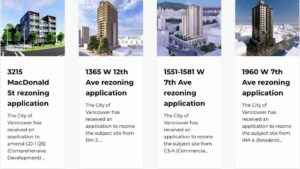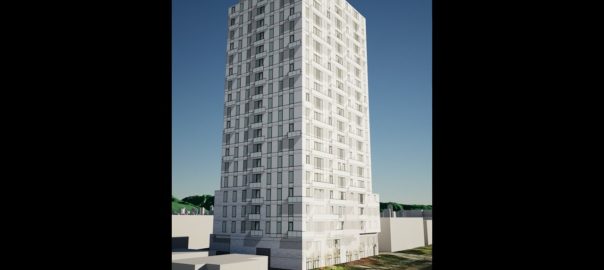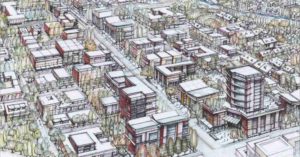
Scot Hein, retired senior designer, City of Vancouver. Adjunct Professor, University of British Columbia.
When Scot Hein spoke at last Thursday’s #KitsPlan Town Hall, held at the Kitsilano Neigbourhood House at West 7th and Vine, to discuss the Broadway Plan, and its implications for our beloved Kitsilano neighbourhood, he bemoaned the fact that in recent years citizens throughout Vancouver have been locked out of the decision-making process that affects the communities where they and we live.

Here is what Scot Hein had to say on the matter of civic democracy …
“As little as 15 years ago, the City of Vancouver regularly engaged in a thorough, often years long, one-on-one, in-person consultation process with citizens, when the City worked toward developing community plans for the future of neighbourhoods across the City, be that in the Grandview-Woodlands, Riley Park-Little Mountain, Kensington-Cedar Cottage or Granville-Fairview communities, or any other Vancouver neighbourhood.
In recent years, consultation and community involvement in the development process in the City of Vancouver has devolved into a top down process, where the community is not — or rarely — consulted, but are rather called out to a community meeting, where white boards are placed on walls at a community centre, announcing the planners’ conception for the development future of a neighbourhood, a development fait accompli if you will, sans any meaningful engagement with the community, or citizens who live in one of the twenty-three neighbourhoods that are the heart of Vancouver.”
Sadly, as former Vancouver City Councillor Colleen Hardwick has often averred …
“The members of City Council have often expressed that organizations like the Coalition of Vancouver Neighbourhoods, or the community resident associations who are members of the Coalition, are extra-legal forms of civic governance, unsanctioned and without mandate, that all civic authority autocratically rests solely and unabashedly with the Mayor and 10 City Council members.”
On February 13th, David Eby’s government launched the BC Builds programme to build rental housing for “middle-income earners”, geared towards those earning between $134,000 and $284,000 annually.
Whether it’s Premier David Eby and his Housing Minister, Ravi Kahlon, or Mayor Ken Sim and the members of Vancouver City Council or, down south, Republican MAGA candidate for President Donald Trump, or in Canada should Conservative Party leader Pierre Poilevre form government following the 2025 federal election, for almost two decades now democracy has been in peril, where high-handed governments impose their will on an increasingly angry and woefully disenfranchised electorate, counterintuitively driving turn out down at the polls during the election period — only 36.3% of eligible Vancouver voters cast a ballot in our City’s 2022 municipal election — as more and more, decision-making is left to the elites.

The thrust of last week’s #KitsPlan Town Hall was to reverse the “trend” towards disenfranchisement, for the community to regain its collective power to influence change for the better, for themselves and their families, to demand a voice and input that would be incorporated into civic and provincial affairs decision-making.
While a diverse crowd attended the Town Hall — encompassing a broad cross-section of the Asian and other communities of colour and ethnicities who reside in Kitsilano, with a demographic representation of the parents of young families also voicing their concerns about the tower-driven Broadway Plan, and what it means for the livability of the Kitsilano neighbourhood — many of those in attendance were comprised of members of the seniors community, and were Caucasian.

An unrepresentative, selectively misleading photo of #KitsPlan Town Hall attendees, posted on X
The Abundant Housing, in-the-pocket of developers “We’ve never met a tower-driven development we didn’t like” naysayers posting on Elon Musk’s X (formerly Twitter) cesspool were quick to selectively call out the attendees at the Town Hall as “universally white” and old. Of course, that was not the case, as we pointed out.

Of course, there was a big online hue and cry that referred to #KitsPlan Town Hall attendees as that most awful of things, a NIMBY (as in Not In My Back Yard). The NIMBY appellation is little more than untoward name-calling and a misrepresentation of the truth. Desiring to maintain a livable community — and an agreed upon and very much desired much more dense community that encompasses a variety of environmentally-sound housing forms — can hardly be called NIMBYism.
You know, too, there was a time in the not-so-distant past when younger members of our community valued those who comprise our seniors community, as elders possessed of wisdom, gained across a lifetime of activist community involvement.

Sadly, no longer it would seem. #FightAgeism and intolerance, VanRamblings says.

In fact, if you were to survey the majority of the seniors who were in attendance at the #KitsPlan Town Hall, you would more than likely find an engaged population of longtime died-in-the-wool community activists, who throughout their lives have fought for a better, a richer, a more diverse and a more inclusive community, who are in point of fact situated on the progressive side of history, and after a lifetime of fighting for better, are unwilling to allow City Hall to steamroll over them and their families, their neighbours, their colleagues and members of the Kits community.

In the days, weeks, months and years to come, there will be more #KitsPlan Town Halls, next time and beyond — as the movement grows — in increasingly larger venues, as members of the Kitsilano community, in increasing numbers, rally in support of the preservation of Kitsilano as a livable, if increasingly dense, family neighbourhood, where all members of the community are valued, where we might live in harmony and good health, where we know our neighbours, where our streets are friendly and safe, where we know the shop keepers in our Kitsilano neighbourhood and enjoy the restaurants we have come to love, where Jericho and Locarno beaches and Spanish Banks are but a hop, skip and a jump away.






